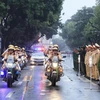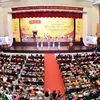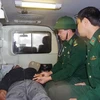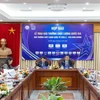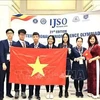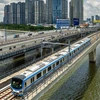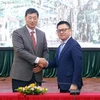Da Nang city, an economic hub of the central and Central Highlands regions, has changed the look of its transport infrastructure, urban planning and local people’s lives after ten years of development.
Recognised as a Grade-1 city in 2003, Da Nang has always been known as one of Vietnam’s leading localities with dynamic development in all aspects. The city is striving to develop itself as a green and smart city as well as a place worth investment and living.
The city’s inner districts make up 16 percent of Da Nang ’s total area of 1,300 square kilometers.
Da Nang was separated from the former Quang Nam-Da Nang province in 1996. It took seven years before it become a Grade-1 city, meeting standards on environment, population density, infrastructure, service quality and management capacity.
The city recorded an average annual economic growth rate of 19 percent from 1997-2012, compared to the national rate of 7.27 percent.
Da Nang ’s economic structure has been reformed in positive and appropriate directions, prioritising the development of its service sector with tourism set to become the spearhead industry.
As a result, the city’s per capita GDP rocketed to 48 million VND in 2012, a ten-fold increase against 1997’s figure.
Da Nang has implemented various social policies that receive support and involvement at all levels, establishing a sound living environment and turning the city into a civilised and modern metropolis.
All-level consensus has helped bring about the city’s increasingly fast development and has become a foundation to establish humanitarian works, especially a hospital offering free medical examinations and treatment to underprivileged local women.
In early 2013, the city opened Da Nang Cancer Hospital to meet local medical examination and treatment needs, just one of the endeavours illustrating the local authorities’ efforts to execute support policies for poor patients.
This is the first cancer hospital in the central and Central Highlands regions built with donations from individuals, enterprises and organisations .
On the 38th anniversary of the city’s Liberation Day (Mar 29, 1975-2013), the city inaugurated three more bridges crossing Han River , of which the “Rong” (dragon) bridge, is regarded as a symbol of the city’s new development stage and growth.
The bridges plays an important role in the city’s urban infrastructure strategies, facilitating the implementation of slum clearance programmes, and creating a new face and a driving force for the city.
The remarkable progress over the past time is made possible with the consensus of local people, said Chairman of the municipal People’s Committee Van Huu Chien.
In the coming time, the city will focus on five strategic breakthroughs in socio-economic development.
They include expanding the service sector, especially tourism and trade services, developing high-tech and information technology industries, establishing comprehensive and modern infrastructure, creating a sound cultural environment and rapidly developing high quality human resources.-VNA
Recognised as a Grade-1 city in 2003, Da Nang has always been known as one of Vietnam’s leading localities with dynamic development in all aspects. The city is striving to develop itself as a green and smart city as well as a place worth investment and living.
The city’s inner districts make up 16 percent of Da Nang ’s total area of 1,300 square kilometers.
Da Nang was separated from the former Quang Nam-Da Nang province in 1996. It took seven years before it become a Grade-1 city, meeting standards on environment, population density, infrastructure, service quality and management capacity.
The city recorded an average annual economic growth rate of 19 percent from 1997-2012, compared to the national rate of 7.27 percent.
Da Nang ’s economic structure has been reformed in positive and appropriate directions, prioritising the development of its service sector with tourism set to become the spearhead industry.
As a result, the city’s per capita GDP rocketed to 48 million VND in 2012, a ten-fold increase against 1997’s figure.
Da Nang has implemented various social policies that receive support and involvement at all levels, establishing a sound living environment and turning the city into a civilised and modern metropolis.
All-level consensus has helped bring about the city’s increasingly fast development and has become a foundation to establish humanitarian works, especially a hospital offering free medical examinations and treatment to underprivileged local women.
In early 2013, the city opened Da Nang Cancer Hospital to meet local medical examination and treatment needs, just one of the endeavours illustrating the local authorities’ efforts to execute support policies for poor patients.
This is the first cancer hospital in the central and Central Highlands regions built with donations from individuals, enterprises and organisations .
On the 38th anniversary of the city’s Liberation Day (Mar 29, 1975-2013), the city inaugurated three more bridges crossing Han River , of which the “Rong” (dragon) bridge, is regarded as a symbol of the city’s new development stage and growth.
The bridges plays an important role in the city’s urban infrastructure strategies, facilitating the implementation of slum clearance programmes, and creating a new face and a driving force for the city.
The remarkable progress over the past time is made possible with the consensus of local people, said Chairman of the municipal People’s Committee Van Huu Chien.
In the coming time, the city will focus on five strategic breakthroughs in socio-economic development.
They include expanding the service sector, especially tourism and trade services, developing high-tech and information technology industries, establishing comprehensive and modern infrastructure, creating a sound cultural environment and rapidly developing high quality human resources.-VNA








